
Short Message Service, commonly abbreviated as SMS, is a text messaging service component of most telephone, Internet and mobile device systems. It uses standardized communication protocols that let mobile devices exchange short text messages. An intermediary service can facilitate a text-to-voice conversion to be sent to landlines.

Palm OS was a mobile operating system initially developed by Palm, Inc., for personal digital assistants (PDAs) in 1996. Palm OS was designed for ease of use with a touchscreen-based graphical user interface. It was provided with a suite of basic applications for personal information management. Later versions of the OS were extended to support smartphones. The software appeared on the company's line of Palm devices while several other licensees have manufactured devices powered by Palm OS.

Nokia 9500 Communicator is a mobile phone produced by Nokia, introduced on 24 February 2004 and released in November 2004. It runs on the Symbian-based Series 80 platform.

The Nokia 9210 Communicator is a third-generation Communicator series mobile phone produced by Nokia, announced on 21 November 2000 and released in June 2001. It greatly improved on the second generation Nokia 9110 Communicator, providing a colour main screen and using an ARM processor. It is one of the few mobile phones able to send and receive fax.
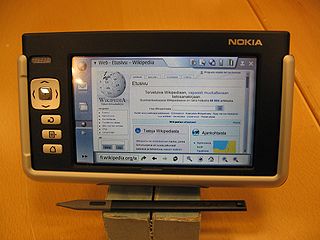
The Nokia 770 Internet Tablet is a wireless Internet appliance from Nokia, originally announced at the LinuxWorld Summit in New York City on 25 May 2005. It is designed for wireless Internet browsing and email functions and includes software such as Internet radio, an RSS news reader, ebook reader, image viewer and media players for selected types of media.

A mobile phone feature is a capability, service, or application that a mobile phone offers to its users. Mobile phones are often referred to as feature phones, and offer basic telephony. Handsets with more advanced computing ability through the use of native code try to differentiate their own products by implementing additional functions to make them more attractive to consumers. This has led to great innovation in mobile phone development over the past 20 years.

Nokia 8210 is a mobile phone by Nokia, announced on 8 October 1999 in Paris. At the time, it was the smallest, lightest Nokia mobile phone on the market. A primary selling point of its design was its removable cover that allowed for easy customization. Six differently coloured Xpress-on covers are available, as well as many third-party ones.

Maemo is a software platform originally developed by Nokia, now developed by the community, for smartphones and Internet tablets. The platform comprises both the Maemo operating system and SDK. Maemo played a key role in Nokia's strategy to compete with Apple and Android, but ultimately failed to surpass both companies.Maemo is mostly based on open-source code and has been developed by Maemo Devices within Nokia in collaboration with many open-source projects such as the Linux kernel, Debian, and GNOME. Maemo is based on Debian and draws much of its GUI, frameworks, and libraries from the GNOME project. It uses the Matchbox window manager and the GTK-based Hildon framework as its GUI and application framework.
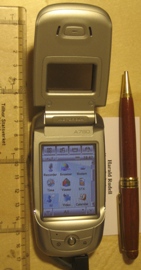
The Motorola A780 is the second cellular PDA running the Linux operating system.
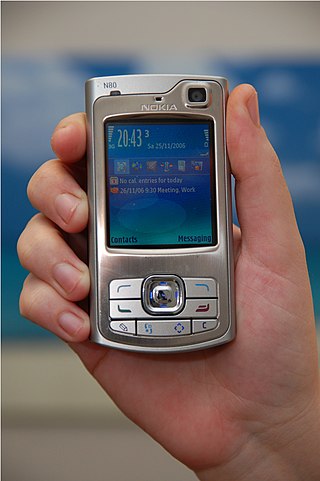
The Nokia N80 is a 3G mobile phone from Nokia announced on November 2, 2005, part of the multimedia Nseries line. It runs on Symbian OS v9.1 and the S60 3rd Edition interface. It was first released in June 2006.

Nokia PC Suite is a discontinued software package used to establish an interface between Nokia mobile devices and computers that run the Microsoft Windows operating system. Its first release was in 1997, originally called Nokia Data Suite. It was replaced by Nokia Suite and integrated into the Ovi service suite.
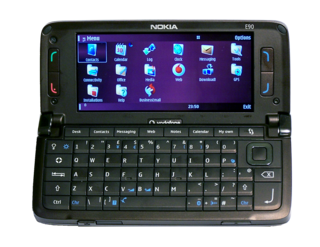
Nokia E90 Communicator is a high-end 3G mobile phone from Nokia, the fifth generation and final Communicator, also part of the Eseries. It was announced on 11 February 2007 at the 3GSM show in Barcelona. It succeeded the Nokia 9500 Communicator as the company's flagship business-oriented device. Its clamshell form and design are reminiscent of older palmtop computers.
A mobile operating system is an operating system used for smartphones, tablets, smartwatches, smartglasses, or other non-laptop personal mobile computing devices. While computers such as typical/mobile laptops are "mobile", the operating systems used on them are generally not considered mobile, as they were originally designed for desktop computers that historically did not have or need specific mobile features. This line distinguishing mobile and other forms has become blurred in recent years, due to the fact that newer devices have become smaller and more mobile unlike hardware of the past. Key notabilities blurring this line are the introduction of tablet computers, light laptops, and the hybridization of the two in 2-in-1 PCs.

The Nokia N900 is a smartphone made by Nokia. It supersedes the Nokia N810. Its default operating system, Maemo 5, is a Linux-based OS originally developed for the Nokia 770 Internet Tablet. It is the first Nokia device based upon the Texas Instruments OMAP3 microprocessor with the ARM Cortex-A8 core. Unlike the three Nokia Internet tablets preceding it, the Nokia N900 is the first Maemo device to include phone functionality.
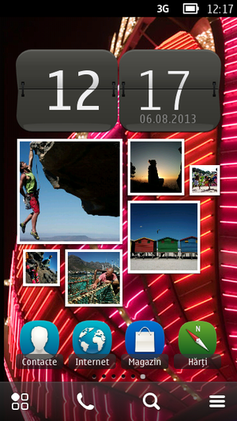
Symbian is a discontinued mobile operating system (OS) and computing platform designed for smartphones. It was originally developed as a proprietary software OS for personal digital assistants in 1998 by the Symbian Ltd. consortium. Symbian OS is a descendant of Psion's EPOC, and was released exclusively on ARM processors, although an unreleased x86 port existed. Symbian was used by many major mobile phone brands, like Samsung, Motorola, Sony Ericsson, and above all by Nokia. It was also prevalent in Japan by brands including Fujitsu, Sharp and Mitsubishi. As a pioneer that established the smartphone industry, it was the most popular smartphone OS on a worldwide average until the end of 2010, at a time when smartphones were in limited use, when it was overtaken by iOS and Android. It was notably less popular in North America.

The Motorola A910 is a clamshell mobile phone from Motorola, which uses MontaVista Linux as the operating system.
SyncEvolution synchronizes Evolution's contact, calendar and task items via SyncML. The items are exchanged in the vCard 2.1 or 3.0 format and iCalendar 2.0 format via the Synthesis C++ client API library, which should make SyncEvolution compatible with the majority of SyncML servers. Full, one-way and incremental synchronization of items are supported.

The Nokia N9 is a flagship smartphone developed by Nokia, running on the Linux-based MeeGo mobile operating system. Announced in June 2011 and released in September, it was the first and only device from Nokia with MeeGo, partly because of the company's partnership with Microsoft announced that year. It was initially released in three colors: black, cyan and magenta, before a white version was announced at Nokia World 2011.
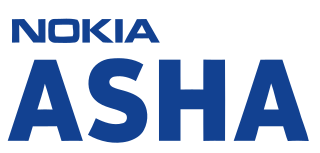
The Nokia Asha 302 is a QWERTY messenger feature phone powered by Nokia's Series 40 operating system. It was announced at Mobile World Congress 2012 in Barcelona along with other Asha phones - the Nokia Asha 202 and 203. The 302 is considered to be among the flagship of the Asha family. Its main features are the QWERTY keyboard, the pentaband 3G radio, SIP VoIP over 3G and Wi-Fi. Its design looks a lot like the older Nokia E6 with chrome slidings, giving it a somewhat premium look. A software update adds Mail for Exchange support.
















